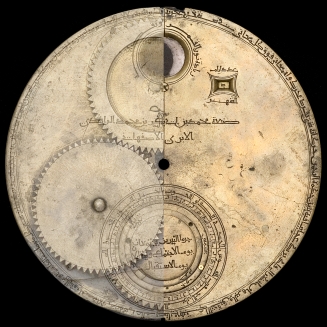| Date | 1221/2 (A.H. 618) |
| Maker | Muḥammad ibn Abī Bakr |
| Place | Iṣfahān |
| Material | Brass |
| Inventory no. | 48213 |
| Acquisition | Presented by Lewis Evans in 1924 |
This early thirteenth-century Persian astrolabe contains the world's oldest complete gear train. In the picture, part of the back of the instrument has been made transparent to reveal the cogs that drive the three calendrical diagrams on the back of the astrolabe. The circular window at the top of the instrument represents the phase of the moon, here showing the first quarter. The small rectangular window to the right gives the age of the moon and thus the date in a lunar calendar. In the bottom, and largest window, two rotating rings represent the relative positions of the sun and moon with respect to each other and their absolute positions in the zodiac, which has been engraved around the edge of that window.
Inside the instrument, between the back plate and the plate that forms the womb of the mater, is a gear train consisting of five cogs. The entire mechanism was turned by an axle attached to the rete on the front. Thus, when set properly, the calendrical diagrams on the back of the instrument reflected the motions of the heavens modelled on the front of the instrument.
By the early 11th century astrolabists in the Islamic world must have been making such geared instruments — the famous Islamic scientist al-Bīrūnī described a similar geared mechanism used for just this purpose. Muḥammad ibn Abī Bakr, the maker of this instrument, whose name appears in the inscription across the back, adopted a simplified design that required only one cog to have an odd number of teeth.
View all
images for this astrolabe
View
detailed provenance for this astrolabe
Mater
The mater and limb are of one-piece construction. The edge of the limb is decorated with pictorial representations of the zodiac alternating with images of warriors.. Scales on the limb: degree scale. More informationBack
The back of instrument contains a set of calendrical diagrams. The upper window represents the phase of the moon. The rectangular window provides the age of the moon. Finally, the lower moving diagram indicates the relative positions of the sun and moon and the sun's location in the zodiac. Attached to the inside of the back plate are five gears, which rotate as the rete rotates and cause the diagrams on the back of the instrument to reflect the current celestial phenomena.. The back contains 1 scales of the following types: Zodiacal signs. The back is inscribed: with a general explanation marked as فلك يريد به هلالاً طلعاً متزيداً ويعود في نقصان ويريد جرما النيرون كليهما يتقابلان به ويجتمعان ويريد مبلغ سير كل منهما في العام أو في الشهر أو في اﻵن نتجته همة عالم بصنائع بنيت على التحقيق والبرهان انظر ٳلى فلك يريد عجابياً فيه تبين حكمة الرحمن حركاته شتى بفرد محرك وله معاني فوق كل معاني في سنة خيع (؟) هجرية (‘Star’ [or 'Heavenly Body'] means an ascending and increasing crescent which decreases again. ‘Sun’ and ‘Moon’ means that both of them face each other and meet. The duration [extent?] of the way of each of them in the year, or in the month or a particular time is a result of the design of him who knows the sciences which are based on methods of verification and demonstrative proof. ‘Look at the heavenly bodies’ means something wonderful in which the wisdom of the Merciful appears through different motions with a single mover. He has different meanings above all meanings. In the year 618 A.H.). Around the entire rim. with a scale label marked as زيادة نور القمر ونقصانه (Increase and decrease of the light of the moon). Around the upper circular (lunar) window. with a scale label marked as عدد أيام الشهر (Number of the days of the month). Above and below the small rectangular (age of moon) window. with a scale label marked as جرما النيرين يجتمعان يوم الاجتماع ويتقابلا يوم الاستقبال (Sun and moon meet on the day of conjunction and they face each other on the day of opposition.). On the volvelle within the lower window. with a maker's signature marked as صنعة محمد بن أبي بكر بن محمد الراشدي اﻹبري اﻹصفهاني (Made by Muḥammad ibn Abī Bakr ibn Muḥammad al-Rāshidī al-Ibarī al-Iṣfahānī.). Main inscription across the centre of the back. More informationRete, Pin & Wedge
The rete contains 0 stars. The rete contains zoomorphs: there are three zoomorphic star pointers on this rete. the first is the typical bird (falcon ?) that indicate the star vega. the second is another bird, this time depicted as if in a dive, which points to the star alsrc=+ayir. the third is a horse that points to the star mankib. The zodiac on the rete is labelled: الحمل , الثور , الجوزا , السرطان , الاسد , السنبله , الميزان , العقرب , القوس , الجدي , الدلو , الحوت .The rete is attached using a pin & wedge. The pin is in fact an axle that rotates with the rete to drive the gears. These, in turn, cause the phase of the moon diagram and the solar-lunar diagram to change accordingly. It looks to be a replacement.. More information



